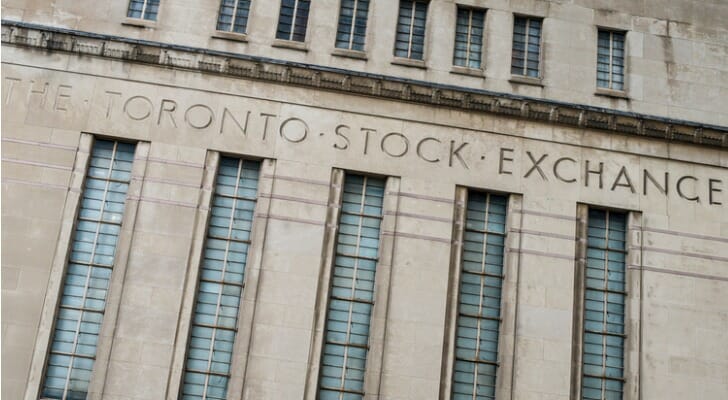Canada is a wealthy, stable country that’s one of the major trading partners of the U.S. and among the top countries in global trade. Its gross domestic product (GDP) is about $1.6 trillion as of 2021, and its economy has strong service industry and natural resource components. It has a stable monetary policy, aiming for a 2% interest rate. It’s not surprising then that Canada has become a premier investment destination. Investing overseas opens many options and can help diversify your portfolio, but there are risks, too. Working with a financial advisor can help you build a reliable investment plan.
The Canadian Stock Markets
There are a number of stock exchanges in Canada, but there are three that are the largest and U.S. investors typically use one of them. The Toronto Stock Exchange is the largest and is the cornerstone of the Canadian stock exchange system. It’s a top-10 largest stock exchange in the world with a $3.1 USD trillion market capitalization as of 2020. The Toronto Stock Exchange trades mostly fixed-income securities, exchange-traded funds (ETFs) and established equities.
The Canadian Securities Exchange, as compared to the Toronto Stock Exchange, focuses on handling small-cap stocks, micro-cap stocks and emerging markets companies. Around 600 companies are currently listed on the exchange, as of the time of this writing. The Canadian Securities Exchange tries to help the companies listed on the exchange gain access to the Canadian public capital markets. It’s actually a fully electronic market.
A third large stock market is the TSX Venture Exchange. The TSX Venture Exchange is for venture capital investments. This exchange focuses on equity venture investments and relatively new companies. Many companies on this exchange do not match the listing requirements of the Toronto Stock Exchange.
ETFs, ADRs and Mutual Funds
The easiest way for Americans to invest in Canada is to buy Canadian-issued ETFs and American Depository Receipts (ADRs). ETFs are similar to mutual funds, but they are traded throughout the day like stocks. They may track one of the Canadian indexes or a particular industry, like the MSCI Canada does. To purchase Canadian ETFs, it’s often best to use either a robo-advisor or a discount brokerage.
ADRs are shares of foreign companies, in this case, those in Canada, that trade on U.S. exchanges. They give the investor the option to invest in Canada without the hassle of using a foreign stock exchange. The Royal Bank of Montreal has a popular ADR.
ADRs develop a relationship with U.S. banks and the bank serves as their depository. This is what allows them to trade on U.S. stock exchanges. ADRs are denominated in U.S. currency, so there’s no hassle with regard to foreign currency or exchanges. ADRs may be approved to trade on the exchanges or only over the counter. Owners of ADRs receive both capital gains and dividend income. However, they may also face a considerable tax liability due to the taxation laws of both the U.S. and Canada.
Both ETFs and ADRs make investing in Canadian companies relatively easy. However, mutual funds from Canada are also a possible investment.
Equities and Fixed-Income Securities

You can also purchase the stocks of individual Canadian companies. There are a number of Canadian stocks listed both on the New York Stock Exchange (NYSE) and over-the-counter. Buying these stocks is probably the easiest method of directly buying stock in Canadian companies.
You can also invest in Canada by buying shares of Canadian companies through the Toronto Stock Exchange. You’ll face currency exchange costs by taking this route, though. You have to be sure that trading fees do not quickly eat up your returns when you are planning your trading strategy.
It would be best to use a good international broker for this type of purchase. The Toronto Stock Exchange boasts more natural resources stocks than any other exchange in the world which makes it susceptible to the volatile prices of commodities. You can buy individual bonds, bond ETFs and bond mutual funds in Canada.
Alternative Investments and Real Estate
As a U.S. citizen, you can’t easily invest in alternative investments like private equity or hedge funds in Canada because they do not trade publicly. You can, however, invest in real estate. Canadian real estate can be a way to diversify your portfolio. You have to be aware of taxation on real estate since you must pay taxes to both the U.S. and Canadian authorities.
Benefits and Risks of Investing in Canada
Canada has an enormous natural resource base, which allows it to both sustain itself and export energy. It’s a stable country with low and stable inflation and a low budget deficit. It compares favorably to the European countries. All of these factors make it a worthwhile foreign investment for American investors.
However, there are risks that come with investing beyond the borders of the U.S. Taxes and transactions fees can be stiff, which should come as no surprise. Also, the Canadian economy has a high correlation with the U.S. economy. In turn, any diversification you may be seeking might not be as stark as in other countries.
Bottom Line

Even though Canada is a wealthy, stable country, it’s similar to the U.S. You can achieve some geographic diversification by investing there, but their asset classes are largely similar. It has such an abundance of natural resources that the avenue to profitable Canadian investing goes right through them. The land is still available, sometimes with mineral rights. The best plan may be to use an international broker to help you navigate possible investments in Canada, but diversification may be better found elsewhere.
Tips on Investing
- Consider working with a financial advisor to help you navigate international investing.
Finding a qualified financial advisor doesn’t have to be hard. SmartAsset’s free tool matches you with up to three financial advisors in your area, and you can interview your advisor matches at no cost to decide which one is right for you. If you’re ready to find an advisor who can help you achieve your financial goals, get started now.
-
Use SmartAsset’s income tax calculator to estimate your tax liability.
Photo credit: ©iStock.com/pictore, ©iStock.com/dbstockphoto, ©iStock.com/AlbertoLoyo
